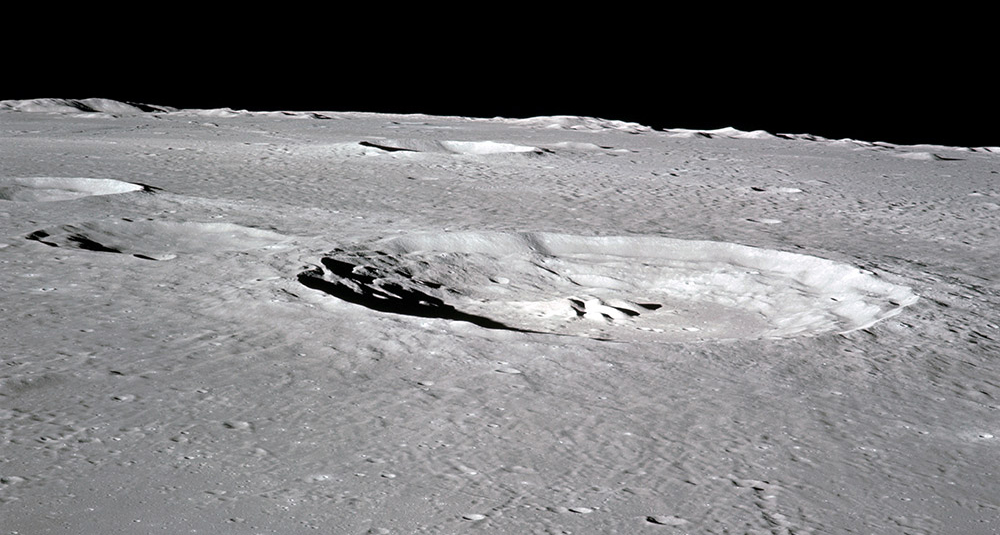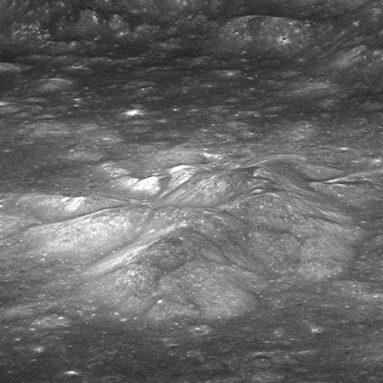Seeing the moon’s water
A moon-orbiting satellite detected traces of water in surface rocks

The moon’s Bullialdus crater formed sometime between 1.1 billion and 3.2 billion years ago.
NASA
By Sid Perkins
In a folktale from the Middle Ages, a fox convinces a wolf that the moon is made of green cheese. That’s not true, of course, as moon rocks collected more than 40 years ago by the Apollo astronauts proved. But some rocky details of our moon can be gleaned without the aid of visiting astronauts. The latest example: An orbiting spacecraft may have just spotted water locked within surface rocks.
Scientists already knew the moon hosts trace amounts of water. That evidence turned up in a few of the moon rocks retrieved by astronauts. Most of these rocks came from deep below the lunar surface. That suggested that surface surveys would not turn up water. Now that they have, scientists may be able to use this information to better understand the moon’s history.
The new findings might help scientists tweak their simulations of how the moon formed, says Alberto Saal. He’s a geochemist (someone who studies the chemistry of rocks and minerals) at Brown University in Providence, R.I. And the new data mean “we don’t have to land to get samples,” explains Saal. “We can look for water anywhere else on the moon.”
The moon’s violent history
Most current simulations suggest that the moon formed when a Mars-sized planet slammed into Earth. This would have sent a large amount of debris into orbit. Scientists had assumed that before that rubble and dust finally came together as our moon, most if not all of any accompanying Earthly water would have disappeared into space, says Saal. But now scientists know that’s not true: Some water became trapped deep inside the moon, ready for something to bring it to the surface. And that something appears to be collisions with asteroids, comets or meteorites.
The new observations came from a spacecraft instrument called the Moon Mineralogy Mapper. It looks at the moon in many wavelengths of light, including ones invisible to the human eye, explains Rachel Klima. She works at the Johns Hopkins University Applied Physics Laboratory in Laurel, Md. A planetary geologist, she studies geological processes on other planets and their moons.

Her team’s mineral mapper examined the sunlight reflected off of the moon. The instrument was looking for the dimming or the absence of one particular wavelength. That wavelength is absorbed by a chemical called a hydroxyl radical. It’s made of one oxygen atom bonded to one hydrogen atom. Water is made of one oxygen atom bonded to each of two hydrogen atoms. So the presence of hydroxyl on the moon might be a strong signal that water is also around, explains Klima.
She and her coworkers looked at images from all over the moon, even the side that never faces Earth. And when their mapper scanned a crater named Bullialdus, it turned up areas with high levels of hydroxyl. The levels were unexpectedly high on boulder-covered peaks inside the crater. (This crater is about 61 kilometers [38 miles] across and named for Ismaël Bullialdus, an astronomer that lived in France in the 1600s.)
The new finding hints that water resides in those rocks, Klima and her team report in the Aug. 25 Nature Geoscience.
Still looking for proof
But the new finding falls short of proof, these scientists admit. It’s possible the hydroxyl inside Bullialdus isn’t caused by water. The sun spews subatomic particles known as protons. When they slam into the lunar surface, they can temporarily bond to its minerals. If those minerals contain oxygen atoms, hydroxyl bonds can form, creating hydroxyl radicals. Such bonds tend to weaken, however, during the course of a lunar day. (In one lunar day, daylight and darkness hours each last about 14 Earth days.) In fact, the mapper data show a consistently strong hydroxyl signal throughout the lunar day. This indicates that any detected hydroxyl probably comes from water bound inside the rocks, Klima and her team conclude.
Many large craters on the moon have peaks inside them. Those peaks formed when large objects, such as asteroids or comets, crashed into the surface. Such impacts can blast a kilometers-deep hole. Material from the hole will be flung upward, and it often freezes to form a mini-mountain. The impact that created Bullialdus probably brought to the surface material that had been buried between 6 kilometers and 9 kilometers underground. Such water-bearing material could have been excavated from even farther below the surface during earlier impacts, says Klima.
Bullialdus was created by an impact 1.1 billion to 3.2 billion years ago, says Klima. That would put its formation at least 1.35 billion years after the moon’s. Even though that collision happened long ago, the telltale debris spotted by the mineral mapper gives researchers even more evidence about the moon’s history. And it now appears the lunar past was wetter than most scientists had realized.
Power Words
Bullialdus crater A 61-kilometer-wide crater on the moon. This feature, visible from Earth using telescopes, is named after Ismaël Bullialdus, a French astronomer who lived during the 1600s.
electron A negatively charged particle included in every atom.
geochemist A scientist who studies the chemistry of rocks and minerals. By knowing those processes, geochemists can better understand how planets and other large objects in the solar system formed and evolved.
hydroxyl radical A substance made from one hydrogen atom chemically bound to one oxygen atom. Its chemical formula is OH– ; the minus sign indicates that the substance has a charge of -1. This unpaired electron, which gives the ion a net negative charge, makes this molecule what chemists call a radical.
lunar Of or relating to Earth’s moon.
planetary geologist A scientist who studies the geological processes that occur on Earth and other large bodies, including planets and their satellites.
proton A positively charged particle included in the nucleus of every atom. When an electron is stripped away from a hydrogen atom, a proton is left behind. The solar wind, a strong flow of charged particles streaming from the sun, is largely made of protons.







